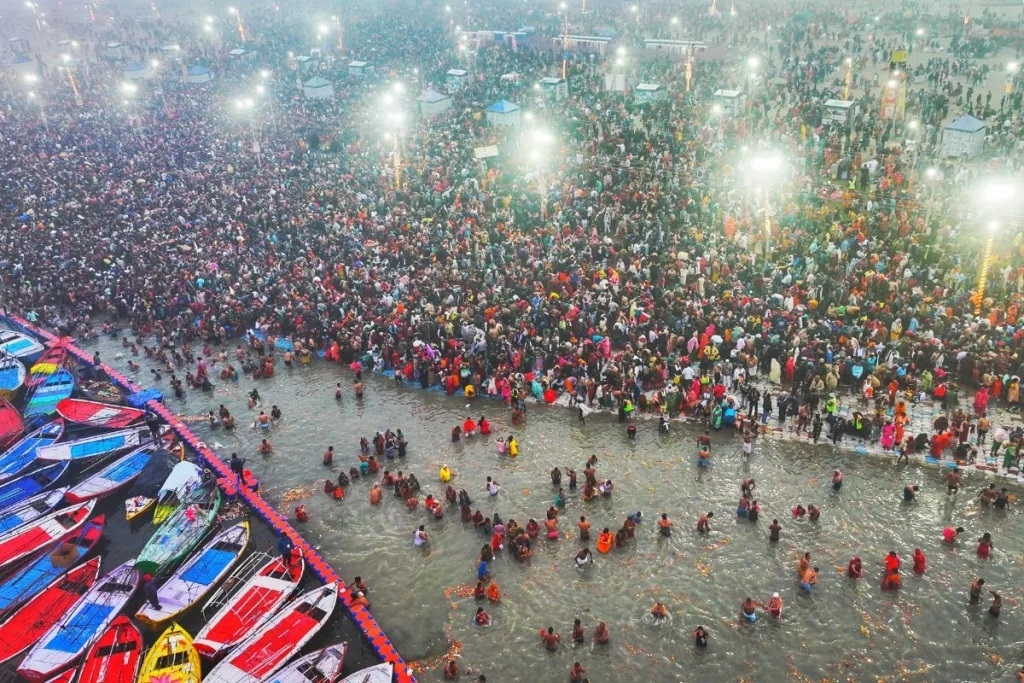Maha Kumbh Mela concludes on Mahashivratri, when and where will the next Kumbh Mela be held? What is its significance?
01 Mar 2025 14:35:42

The Mahakumbh Mela in Prayagraj, which began about six weeks ago, i.e. on January 13, will conclude today on the auspicious occasion of Mahashivratri. The last Amritsnan (bathing of nectar) will be held in the Mahakumbh Mela today. Mahashivratri holds special significance in the Mahakumbh Mela. On February 25, around 1.33 crore devotees took a holy bath at the Triveni Sangam and other ghats in the Mahakumbh Mela. According to the Uttar Pradesh government, the total number of devotees during the fair was more than 64 crore. Let's know about the importance of the Mahakumbh Mela, the importance of Amritsnan and when will the Kumbh Mela be held next?
Significance of Mahakumbha
A rare celestial alignment has brought the six-week-long Maha Kumbh Mela after 144 years. It is believed that bathing during this time at the Triveni Sangam (the confluence of the Ganges, Yamuna and Saraswati rivers) washes away a person's sins and improves their karma. According to Pallavi Jambhale, associate professor and director-in-charge of the KJ Somaiya Institute of Religion Studies, Diana Eck, in her research on the Kumbh Mela, has linked its significance to the cosmic battle between gods and demons, the myth of nectar. Diana Eck is a professor at Harvard University. Her work on India focuses on popular religion, especially temples and pilgrimage sites.
The Kumbh Mela, held every three years in the four holy places of Prayagraj, Haridwar, Ujjain and Nashik, is deeply connected to celestial formations, especially the movements of the Sun, Moon and Jupiter. However, the Mahakumbh, held only every 12 years in Prayagraj, is considered more significant. The Mahakumbh revolves around the ritual of bathing or Amritsnaan at the holy confluence of the Ganges, Yamuna and Saraswati, which is believed to cleanse sins and bring people closer to salvation.
When and where will the next Mahakumbh Mela be held?
The next full Kumbh Mela will be held in Nashik, Maharashtra in 2027. Known for its deep spiritual and mythological significance, Nashik will host the 'Simhastha Kumbh Mela' in the Trimbakeshwar area on the banks of the Godavari river. According to a report by 'Times of India', the Kumbh Mela in Nashik is believed to have been taking place since at least the 17th century and is known for its grandeur. Lakhs of devotees participate in this Kumbh Mela. The Maharashtra government has started preparations for the Kumbh Mela. Public Works Department (PWD) Additional Chief Secretary Manisha Patankar Mhaiskar recently visited Nashik and discussed plans to improve roads, infrastructure, traffic management and connectivity, a report in 'Mid-Day' said. Meanwhile, the Simhastha Mahakumbh will be held in Ujjain in 2028 and the Ardh Kumbh in Prayagraj in 2030.
Importance of Amritsnana
According to Hindu mythology, Amritsnana is a symbol of purification and the quest for immortality. According to Acharya Swami Avadheshanand Giri Maharaj, the Peethadheeshwar of Juna Akhara, the yoga of Amritsnana occurs when Jupiter enters Taurus and the Sun and Moon enter Capricorn. This rare cosmic alignment, known as 'Amrit Yoga', occurs once every 12 years. Swami Avadheshanand emphasized that changing the name of Shahisnana to Amritsnana does not change its essence or significance. Mahant Adittanand Shastri of Agni Akhara likened Amritsnana to a thousand Ashwamedha yagnas. After Amritsnana, sadhus and saints meditate on the gods and discuss knowledge.
Ramesh Kumar Upadhyay, president of the Indian Astrology and Spirituality Council in Jamshedpur, explained that the Amritsnaan on Makar Sankranti is important for Hindus. The Uttarayan period begins on Makar Sankranti as the sun moves northwards. According to Hindu mythology, this period is believed to be the day of the gods. Six months later, the sun is in the southern phase, which is the night of the gods. The sun also moves out of Sagittarius, due to which auspicious works are not performed for a period of 30 days, he told The Indian Express. The 'Amritsnaan' is marked by the participation of 13 akhadas (religious orders), with each ritual bath observing a designated time.
What is the significance of each Amritsana?
Paush Pournima: The Mahakumbh began on January 13, the full moon day of Paush Pournima. This day marked the beginning of a month-long period of spiritual meditation for devotees. Taking a holy bath in the Ganges on the full moon day is considered auspicious, as the bright light of the moon is believed to symbolize inner peace and the removal of impurities.
Makar Sankranti: The second Amritsnaan takes place on Makar Sankranti on January 14. It is believed that taking Amritsnaan on the day of Makar Sankranti will remove any darkness or ignorance from the lives of the devotees.
Mauni Amavasya: On January 29, the Amritsnan of Mauni Amavasya will take place. During this time, devotees observe a vow of silence. On Mauni Amavasya, people decide to remain silent and meditate. It is believed that bathing on this day washes away their sins and also improves their speech.
Vasant Panchami: The Amritsnaan of Vasant Panchami on February 3 is believed to bless people with not only knowledge but also character and creativity. Vasant Panchami is the day of Goddess Saraswati, who bestows knowledge, creativity and wisdom on people.
Maghi Pournima: Those who donate on the day of Amritsnana on February 12, on the day of Maghi Pournima, receive good fortune. On this day, devotees are advised to meditate and help others.
Mahashivratri: The last day of Amritsnana is on February 26. Mahashivratri is considered to be the great night of Lord Shiva, when his energy and vibrations are at their most powerful. Taking bath on this day is believed to remove all kinds of ignorance from a person's life and bring the person closer to Lord Shiva.